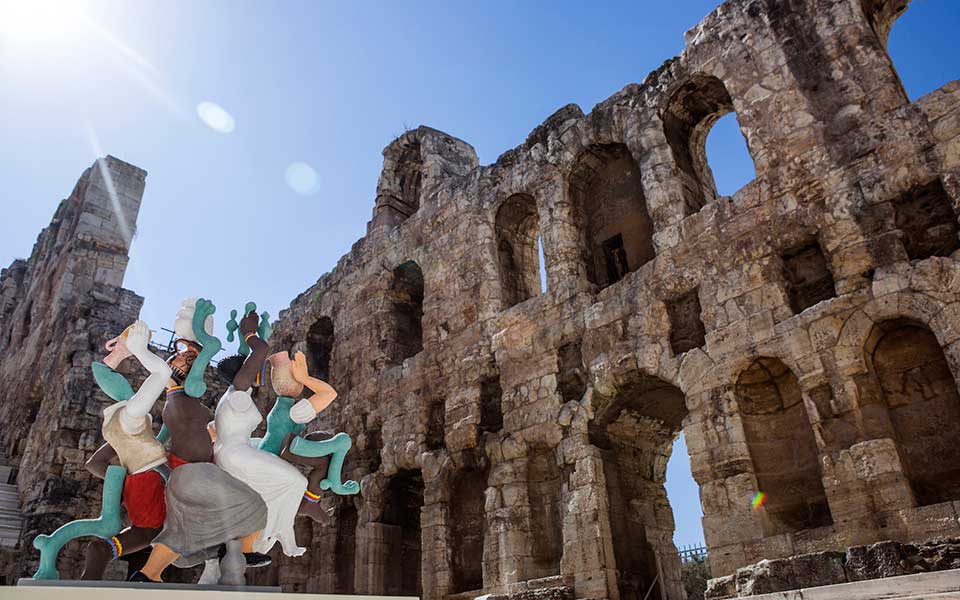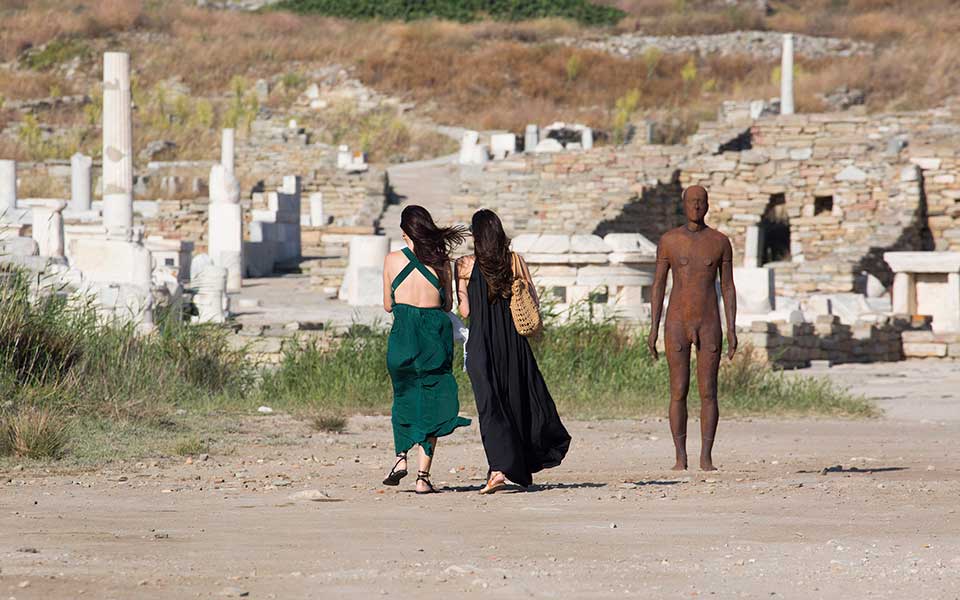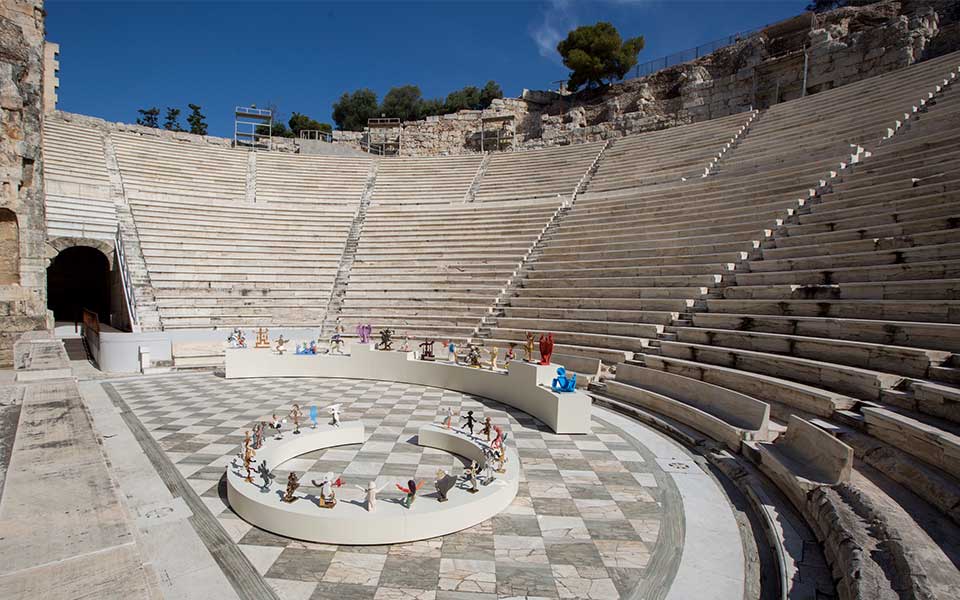What’s Really Happening in Messinia?
The Olympic elite, Hollywood’s finest, the...

D. Kavallieratos’ installation: “Disoriented Dance/ Misled Planet” at the Odeon of Herodes Atticus.
© Natalia Tsoukala
It was this time a year ago on the island of Delos that Dimitris Daskalakopoulos was welcoming luminaries from around the world to the sacred island; they had come to see the fantastic exhibition of works by sculptor Sir Anthony Gormley. NEON, the cultural non-profit he founded in 2013, had pulled off a small organizational and artistic miracle, resulting in a deeply moving collective viewing experience.
Over the past few years, Daskalopoulos has embodied the role of “sponsor” in a highly effective yet low-key manner, supporting large-scale cultural projects through NEON. However, the pandemic has now changed everything, including the way we experience art, bringing with it digital guided tours and limited visitor numbers in museums.
Given the new landscape, how does he see the future?
“I believe,” says Daskalakopoulos, “that contact with a great object of human creation is a basic human need. It creates an inner mystery; it fills us with delight and reflection. It is a deeply personal experience, one that does not require teamwork. Whoever is interested in art will rapidly seek to experience it again.
“Besides, we will gradually put our fear of the coronavirus into perspective, in relation to all the other risks we run in our lives. The mystery born from contact with art cannot be reproduced on a screen. It is a matter too serious to be lost in WhatsApp chatter or absently overcome by a motion of the thumb on Instagram.”

The exhibition organized by the NEON Cultural Organization last year on the island of Delos received many visitors.
© Natalia Tsoukala
“Big museums haven’t changed much in their 300 years of existence, and that’s because they constitute the ideal environment for the contemplation caused or demanded by art. They are the institutions that gather knowledge, research, and critical thought for the perpetual promotion of artistic creation. They may use new technological tools to facilitate their task, as in fact they did before the pandemic, but their mission hasn’t changed, and the work they do can’t be replaced.”
I ask Daskalakopoulos if the absurd times we’re living through will inspire contemporary creators. He replies: “I remember what I said in 2010: ‘I look forward to the shock of the crisis. It can be a call to arms to the most restless and creative forces of society, those with iconoclastic readiness.’ And I think I got it right then: contemporary creativity has not degraded in the last decade. On the contrary, it has blossomed.
“Culture can get us out of stagnant waters. Now, again, we need creative perception, which is a hope for the future. And who can provide it better than people of true creation, in conversation with all of us? I’m waiting to hear from them. Of course, art cannot change the world by itself. What changes the world are democratic government institutions and inspired political initiatives.”

Disoriented dance / Misled planet is part of NEON City Project 2020. Featuring work by sculptor Dionysis Kavallieratos, it has brought contemporary art to the Odeon of Herodes Atticus for the first time.
© Natalia Tsoukala
Since its founding, NEON has been working to expose Greek people from all backgrounds and educational levels to artistic creation in public spaces. At the same time, the organization has reintroduced us to monuments and locations throughout Athens.
Their new exhibition, inaugurated last Friday at the Odeon of Herodes Atticus, features sculptures by Dionysis Kavallieratos. It goes without saying that all current health safety standards are being met to protect the viewing public.
“NEON is a nomadic organization by conscious choice,” Daskalakopoulos notes as our conversation continues. “Since it could not – and did not want to – be a big museum, it cannot – nor wishes to – be limited to one closed space. I believe this makes our actions more unpredictable and, I hope, more exciting for the public. Like now: free contemporary art at the Odeon, in broad daylight.
“The utility of public art lies not only in its aesthetic dimension, but also in its ability to trigger dialogue and debate regarding the importance of public space and the value of artistic creation. In Greece, during the crisis, public space was probably a mirror of weak collectiveness rather than a field of social coexistence. That is why this dialogue is often resentful and sterile. But it is only through repetition that we will shake off any resentment and sterility wherever they exists. Then will we see interesting art inside and outside of our cities.”
This article was first published in Greek by kathimerini.gr
The following is via neon.org:
NEON and the Athens & Epidaurus Festival are pleased to announce a newly commissioned site-specific installation by Greek artist Dionisis Kavallieratos at the Odeon of Herod Atticus, Athens. The exhibition Disoriented dance / Misled planet is part of NEON City Project 2020 and will be the first ever contemporary art exhibition to be staged in this ancient venue situated below the Acropolis.
The new partnership with the Athens Festival comes amidst a challenging period for society and allows NEON to contribute to re-establishing the city’s cultural activities and to reconnecting with artists and the public at the archeological site.
Curated by Polina Kosmadaki, Art Historian & Curator, Benaki Museum, Athens.
CITY PROJECT is an initiative for public art and the city, conceived and commissioned annually by NEON to a Greek artist. NEON aims to activate public and historical places through contemporary art, contributing to the interaction of art, society and the city.
Visitor Instructions
The exhibition will take place in accordance with the health authorities’ advice on social distancing, prioritising health and safety. In light of this, the exhibition will have a maximum capacity of twenty people, with entry permitted every twenty minutes.
For wheelchair users and people with severe mobility difficulties, ramped access is provided. For more information please contact us at [email protected]
OPENING HOURS
Tue – Sun | 5pm – 8:30pm
Mon | Closed
FREE ENTRANCE
Pre-booking is essential.
Please book date and time of visit here.
The Olympic elite, Hollywood’s finest, the...
Ten must-do experiences in Athens, from...
From historic landmarks to edgy street...
Discover Greece’s islands in September with...